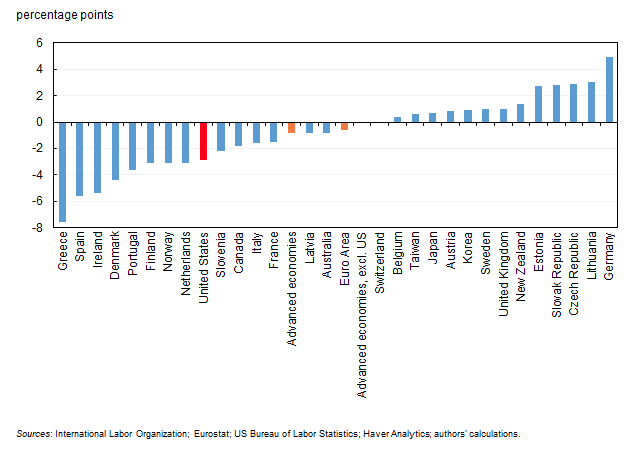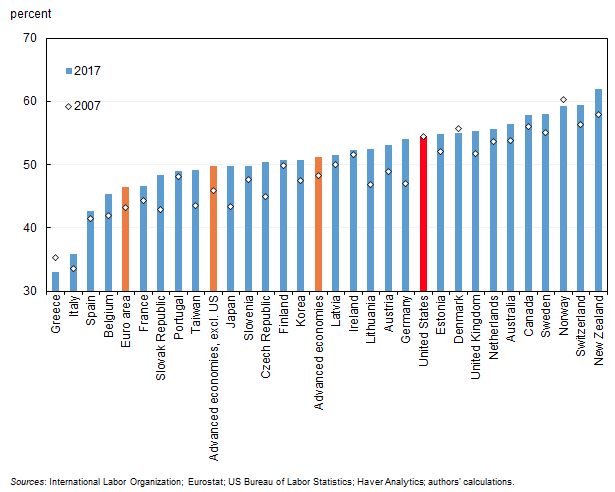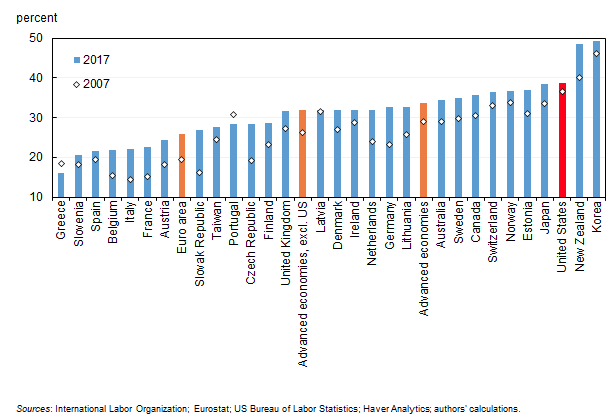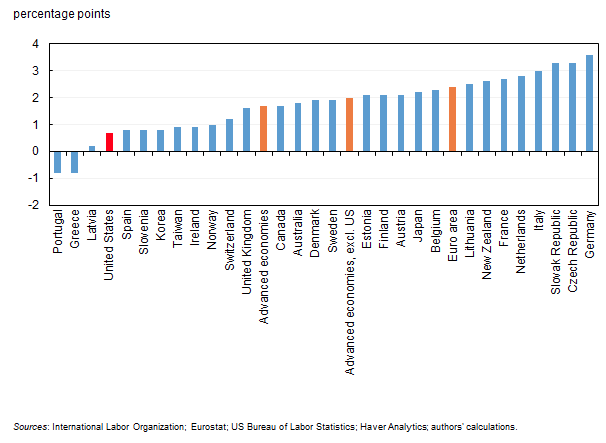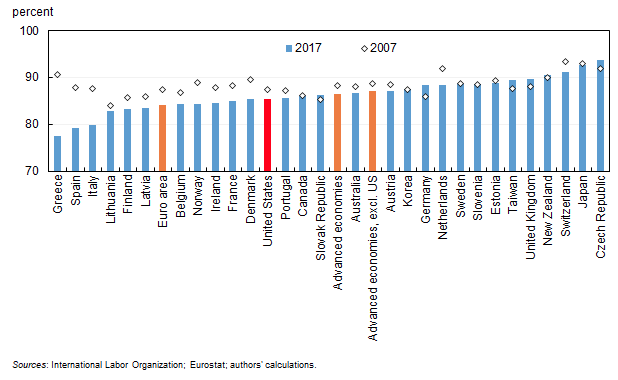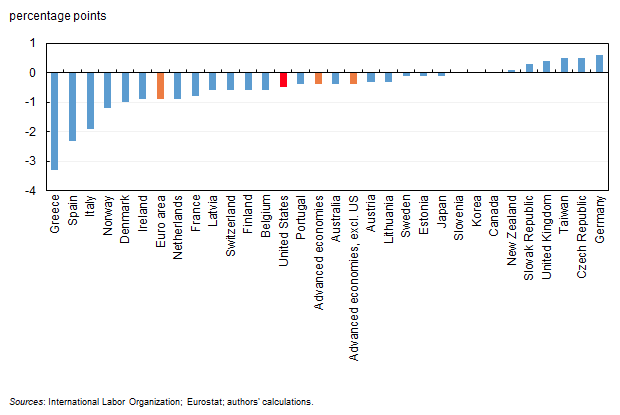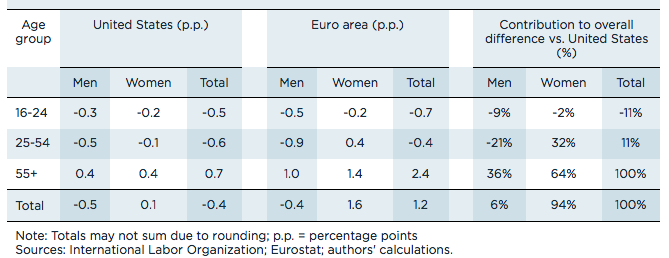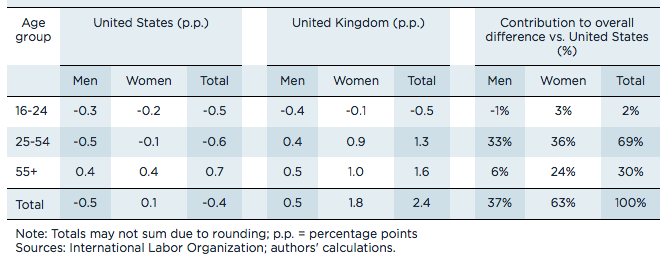From 2007 to 2017 the fraction of Americans employed fell by 2.9 percentage points (Bureau of Labor Statistics n.d.). As we discussed in a blog post co-authored with Harris Eppsteiner (Eppsteiner et al. 2018), the ageing population has been driving the decline in the US employment-population ratio, or employment rate. (The employment-population ratio, or the employment rate, is the fraction of the overall population working, and as such it reflects a combination of the labour force participation rate and the unemployment rate.)
In contrast, employment rates actually rose in 13 of 29 advanced economies from 2007 to 2017, even though they also faced a similar headwind of an ageing population. Moreover, after adjusting for changes in the age-sex structure within each country, employment rates rose in 21 of 29 advanced economies during this period.1
The biggest difference between employment rates in the US and other advanced economies has been changes in female employment rates, which, adjusting for changing age structures, were stable in the US but increasing elsewhere. This factor is responsible for 77% of the ageing-adjusted difference in employment performance between the US and other advanced economies over this period. The second largest source of difference is converging employment rates for older workers (defined as 55 and older), as other countries increased their employment rates towards the US level. This factor is responsible for 52% of the difference with other advanced economies. (These two explanations overlap because both include women age 55 and older.) Employment for prime-age men and younger workers fell almost everywhere but at similar rates in the US and other advanced economies.
These comparisons can help us better understand the major differences in the employment experiences of the US and other advanced economies in the wake of the global financial crisis – especially focusing on the role of divergent structural policies in divergent employment rate experiences.
The dataset we produced to generate these results, based on International Labor Organization (ILO) data with some standardizations discussed in the appendix, is available here.
US employment rates have generally fallen short of other countries
Employment performance in advanced economies has differed from the onset of the global financial crisis in 2007 to 2017, ranging from a 4.9 percentage point increase in the employment rate in Germany to a 7.6 percentage point decline in the employment rate in Greece (Figure 1). Of the countries with larger declines than the US (2.9 percentage points), many, like Greece, Portugal, and Spain, had much more severe recessions and slower recoveries.
Figure 1 Change in employment-population ratio, 2007-17
Population ageing has been a headwind for employment rates throughout the advanced economies. At older ages, employment rates fall dramatically. An increase in the share of the population in older age groups will, all else equal, lower the overall employment rate. We can estimate the aging effect in a country by analysing what would have happened to employment had employment rates been fixed within age-sex groups, but the relative sizes of those groups changed to reflect the actual demographics in that country from 2007 to 2017. (We call these changes “ageing”, although it factors in changes by both sex and age.)
This exercise shows that, on average, ageing subtracted 2.3 percentage points from employment rates across the advanced economies, ranging from a 4.0 percentage point drag in the Netherlands to a 0.3 percentage point increase in Latvia and Estonia. Ageing played a somewhat larger than average role in the US (–2.5 percentage points) and a smaller than average role in the euro area (–1.9 percentage points).
Adjusted for ageing, employment rates rose in 21 of 29 advanced economies from 2007 to 2017, with an overall gain of 1.4 percentage points for advanced economies as a whole, similar to the 1.2 percentage point gain for the euro area (Figure 2). The ageing -adjusted employment rate in the US fell by 0.4 percentage point from 2007 to 2017 (note, as discussed in our previous blog, it rose slightly from 2007Q4 to 2018Q1). The remainder of this blog post analyses the sources of these differences in ageing-adjusted employment rates.
Figure 2 Change in ageing-adjusted employment-population ratio, 2007-17
The biggest difference between the US and other countries is the employment experience of women
In 2007 employment rates for women were generally higher in the US than in other advanced economies. Over the next decade this trend reversed, as employment rates increased in other countries while staying flat in the US (after adjusting for aging within countries), as shown in Figure 3 (note different age structures between countries affect some of the cross-country comparisons). Some evidence indicates that policies like flexible workplaces, paid leave, and childcare subsidies in other advanced economies explain about one-third of this difference (Blau and Kahn 2013).
Figure 3 Female ageing-adjusted employment-population ratio, 2007 and 2017
Overall, adjusted for ageing, women had almost zero net impact on employment rates in the US, but they raised employment rates by 2.0 percentage points in other advanced economies, 1.6 percentage points in the euro area, and 3.3 percentage points in Japan (Figure 4).
Figure 4 Contribution of women to change in overall ageing-adjusted employment-population ratio, 2007-17
International convergence towards higher US employment rates for older workers
The shift of economies towards higher fractions of the population in older age groups was a drag on employment rates almost everywhere. But increasing employment rates within older age groups pushed in the other direction.
In 2007 the employment rate for workers age 55 and older in the US was well above that of almost all other advanced economies. The employment rate for these workers rose in the US from 2007 to 2017, largely due to increased education (Maestas and Zissimopoulos 2010), contributing to the reduced physical demand of jobs, the increased number of women in the workforce, and the fact that men married to working women are likely to retire later (Schirle 2008). The employment rate for older workers rose even more sharply in other countries as the same factors operating in the US coincided with pension reforms (Coile et al. 2018), which increased incentives to work longer in many countries. This led to an overall convergence towards US employment rates for older workers, although most other countries still lagged the United States by the end of the period (Figure 5).
Figure 5 Age 55 and older ageing-adjusted employment-population ratio, 2007 and 2017
Overall, adjusted for ageing, increased employment rates for workers 55 and older added 1.7 percentage points to the overall employment rate in advanced economies and even more in the euro area (+2.4 percentage point). In contrast, older workers added only 0.7 percentage point to the overall employment rate in the US (Figure 6).
Figure 6 Contribution of age 55 and older to change in overall ageing-adjusted employment-population ratio, 2007-17
Similar performance for prime-age men from 2007 to 2017
While employment rates have generally been rising for women and older workers, they have been falling for prime-age men, defined as those between 25 to 54 years old (Figure 7). In 2017, the US prime-age male employment rate, at 85%, lagged behind other advanced economies on average (87%) and substantially below both the UK (90 percent) and Japan (93%) but above the euro area, which has been dragged down by sharp declines in Greece, Spain, and Italy in the aftermath of the global financial crisis. On an aging-adjusted basis, the employment rate for prime-age men in the US fell over the last decade but by a similar magnitude as the deterioration in other advanced economies as a whole.
Figure 7 Prime-age male ageing-adjusted employment-population ratio, 2007 and 2017
As a result, the fall in prime-age men’s participation in the workforce subtracted a similar amount from the overall employment rates in the US and other advanced economies (Figure 8).
Figure 8 Contribution of prime-age men to change in overall ageing-adjusted employment-population ratio, 2007-17
A complete accounting for differences in employment rates across countries
Overall, the ageing-adjusted employment rate in the US fell 0.4 percentage point from 2007 to 2017 as shown in the leftmost set of columns in Table 1. Decomposing this into contributions of six age-sex groups, for example, reveals that reduced employment rates for prime-age men subtracted 0.5 percentage point while increased employment rates for older women added 0.4 percentage point.
Similarly, the 2.1 percentage point increase in the advanced economies excluding the US can be decomposed into contributions of these same groups as shown in the middle set of columns in Table 1. Finally, the last set of columns show the share of the 2.5 percentage point difference between the US and other advanced economies that is attributable to these different age-sex groups.
Table 1 Contribution to change in ageing-adjusted employment-population ratio from 2007 to 2017, US vs advanced economies excluding US
For example, the two largest sources of difference are employment rates for women age 25 to 54 and women age 55 and older. The first group subtracted 0.1 percentage point from the ageing-adjusted employment change in the US while adding 0.8 percentage point in other advanced economies. This 0.9 percentage point difference in performance is thus responsible for 37% of the overall 2.5 percentage point difference in labour market performance between US and other advanced economies. While employment rates for women age 55 and older did increase in the US, they also increased by 0.9 percentage point more in other advanced economies.
Comparing the US with the euro area, nearly two-thirds of the 1.6 percentage point difference in employment performance from 2007 to 2017 is accounted for by women age 55 and older (table 2). In fact, nearly all of the difference is accounted for by women or, alternatively, by older workers.
Table 2 Contribution to change in ageing-adjusted employment-population ratio from 2007 to 2017, US vs euro area
Comparing the US with the UK, women are again the biggest source of difference in labour market performance—but the UK substantially outperformed the US (and other countries) for prime-age workers as well, including both men and women (Table 3). Rising employment rates for older workers also explain some of the US-UK difference but are a smaller factor than for many other countries.
Table 3 Contribution to change in ageing-adjusted employment-population ratio from 2007 to 2017, US vs UK
Conclusion: Highlighting the importance of structural labour market policies
Some of the differences in employment performance across countries—like the collapse in employment in Greece and the rise in Germany—are clearly due to cyclical demand factors. Some critical structural factors, however, have had very different impacts on different countries. The most important of these is women’s employment, which stagnated in the US while increasing in most of the other advanced economies. Another important factor in explaining different labour market performances has been the concerted effort by other countries to increase employment rates for older workers, which have still not caught up to the US. Finally, in almost all countries employment rates have declined for prime-age men and younger workers, although these declines have been similar for the US and other advanced economies and thus are not an important explanation of the differences in labour market performance.
Editors' note: This column first appeared on PIIE Realtime Economic Issues Watch.
References
Blau, F D and L M Kahn (2013), "Female Labor Supply: Why Is the United States Falling Behind?", American Economic Review 103(3): 251-256.
Coile, C, K Milligan and D A Wise (2018), "Working longer", introduction and summary to the eighth phase of the "Social Security Programs and Retirement Around the World" project.
Eppsteiner, H, J Furman and W Powell III (2018), "The US Employment Rate Has Returned to Its Pre-Recession Level Adjusted for Aging", PIIE Realtime Economic Issues Watch, 6 April.
Maestas, N and J Zissimopoulos (2010), "How Longer Work Lives Ease the Crunch of Population Aging", Journal of Economic Perspectives 24(1): 136-160.
Schirle, T (2008), "Why Have the Labor Force Participation Rates of Older Men Increased since the Mid‐1990s?", Journal of Labor Economics 26(4): 549-594.
Appendix
The data in this blog post are from the International Labor Organization’s ILOSTAT database, which provides population and employment data by age and sex for each country. The sample includes 29 of the 39 countries classified as advanced economies by the International Monetary Fund in its April 2018 World Economic Outlook that (1) had a full set of population and employment data for 22 age-sex cells (5-year age groups between 15 and 64, and 65 and older)2 for 2007 to 2017 and (2) had an average annual working-age (15 and older) population of at least 1 million people. Data for the overall euro area is from the Eurostat “Population by sex, age, citizenship and labour status” database. The advanced economy aggregates are weighted averages created by summing the population and employment of the constituent countries within each age-sex cell.
The effect of ageing is calculated by fixing the employment-population ratio in each of the 22 age-sex cells at the average of its level in 2007 and 2017 and then allowing the population distribution to follow its actual path. Conversely, the aging-adjusted change in the employment-population ratio is calculated by fixing the population share of each of the 22 age-sex cells at the average of its level in 2007 and 2017 and then allowing the cell-specific employment-population ratio to follow its actual path. Together, the aging effect and the ageing-adjusted change sum to the actual change in the overall employment-population ratio. The demographic adjustments account for changes in population within country over time; they do not address differences in population structures across countries.
Certain European countries (Denmark, Estonia, Finland, Latvia, Norway, and Sweden) report population data but not employment data for their population over the age of 74.3 This artificially lowers the employment rates reported for the population as a whole, but particularly for the over 65 population. To adjust for this omission we use data from the US (Bureau of Labor Statistics) and the euro area and European countries (Eurostat) that report both employment and population data for the 75 and older population to estimate a relationship between the employment-population ratio for the population aged 70 to 74 and the employment-population ratio for the population aged 75 and older. These estimated employment-population ratios for the 75 and older population are then combined with actual employment-population ratios for the population aged 65 to 74 to create a revised estimate of the employment-population ratio for the population aged 65 and older. We estimate the relationship separately for men and women, using data for all years from 2007 through 2017.
The full set of data is available for download here.
References
Bureau of Labor Statistics (n.d.) "Labor Force Statistics from the Current Population Survey".
Endnotes
1. Ageing-adjustment refers to adjusting for changes in the age-sex structure within a country over time. We do not adjust for the fact that different countries have different age structures.
2. Data for Italy, Spain, the UK, and the US are for ages 16 and older.
3. In certain years, Norway and Sweden were also missing population data for the 75 and older population. In these cases, population data for the 75 and older population was obtained from national sources and then combined with data from Eurostat to create a consistent population series for the 65 and older population over time.

